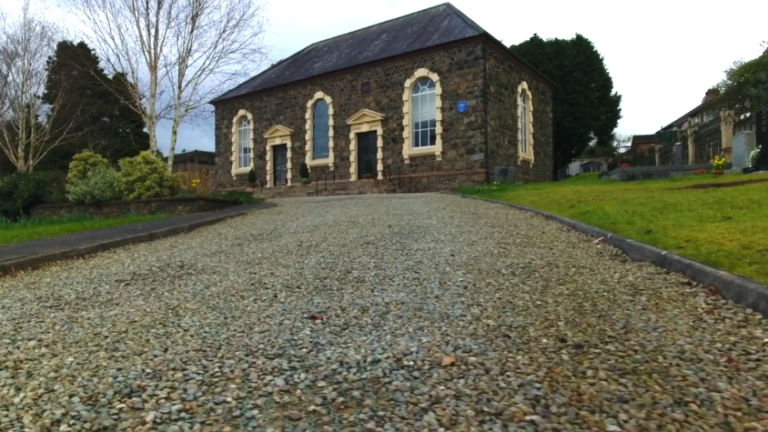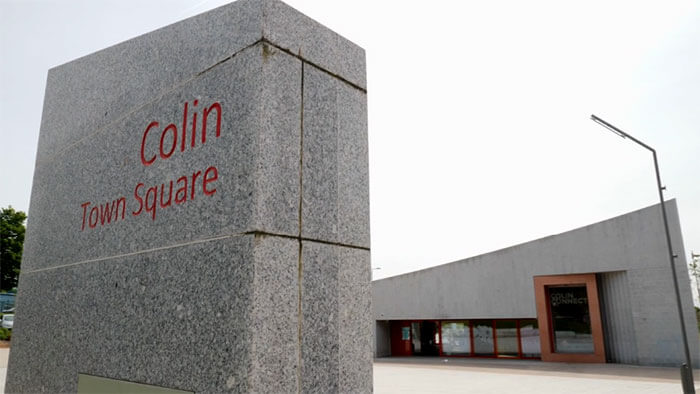Places of Colin
The area around Colin is bursting with historical sites. Here are some of them
Places to see, think and do ...
The area of Colin has a fascinating history, not just to do with its people but in its places as well.
Ancient ruins, famous churches, and a victorian mansion oozing history are just some of the interesting places to visit.
But it’s not just old buildings that are interesting here. We also have some fascinating modern places to visit too – like an award-winning modern transport hub and a beautiful glen and adventure park.
Here we list some of the places to visit in Colin.
Teeling's Mill

The remains of Teeling’s Mill, at Springbank near Poleglass, is of real historical significance.
The Teeling family were wealthy Catholic industrialists from Lisburn, several of whom joined the United Irishmen and took part in the 1798 rebellion.
However, after the rebellion was put down, revenge was taken on the Teelings. Not only was Luke Teeling executed in in Royal Barracks in Dublin, but Teeling’s Mill was burned to the ground as further punishment.
It is said so appalled were local Presbyterians at the destruction of the mill, that no-one would buy or rent the property.
Certainly, that may explain when Teeling’s Mill remains as a wreck, with its basalt stones still standing about six feet high and the mill race still visible behind. An interpretive sign marks the spot and tells the story.
You can learn more from our video about Teeling’s Mill above.
Dunmurry Non-Subscribing Presbyterian Church

Lovely old Dunmurry Non-Subscribing Presbyterian Church is a beautiful example of both architectural style and of the history of the Presbyterian Church in Ireland.
Standing on Glebe Road amid graves and a manse, it is a plain but eye-catching church in the Scottish barn style.
While the history of Presbyterianism in Ireland can be traced back to 1613, the first Non-Subscribing Presbytery was formed in 1725 by the Rev. Dr. Henry Montgomery, minister of the church.
He took a leading part in the controversy in the 1820s that led to the formation of the Non-Subscribing Remonstrant Synod of Ulster.
It is said that Daniel O’Donnell, the ‘Liberator” and friend to Rev. Henry Montgomery once stayed overnight in the manse.
The church itself dates initially from 1676. The present church dates from 1779. The architect is thought to have been Roger Mulholland who designed First Church in Rosemary Street, Belfast in 1783.
In 1900, a beautiful stained-glass window depicting the McCance family’s journey to church was erected in memory of John McCance and his brother Henry, both linen magnets.
The window was partly restored after being damaged by a bomb blast in the 1970s when a nearby railway signal box was blown up.
In 1976, the Pulpit was restored as a memorial to Miss E Andrews, whose father was Thomas Andrews who was lost in the sinking of the Titanic. Find out more in The Lion of Dunmurry – Rev Henry Montgomery.
Cloona House: the last surviving big house in the area

Cloona House, with a long and interesting history, has become the heart of the Colin area.
It is a substantial Victorian mansion, built in the Italianate style, by linen merchant Nicholas Grimshaw, part of the lineage of the famous and wealthy Grimshaw family from the north fo England.
Grimshaw’s daughter Beatrice Grimshaw was brought up and educated there before setting off on a career as sportswoman, journalist, author and high-seas adventurer.
It was home to the Jaffe family – who sadly fled Northern Ireland after coming under pressure in wartime due to their German heritage – and others.
In 1939, it was taken over by the Ministry of Defence and served as the home of the General Officer Commanding of the British Army in Northern Ireland. Much wartime and post-war planning would have taken place there.
It was still home to the GOC during the 1970s even as nationalist west Belfast grew and effectively surrounded it.
In 1980 it was bought by the Catholic Church. It has been used for community projects and, since 2011, has been occupied by Colin Neighbourhood Partnership.
You can find out more in our video The Secrets of Cloona House.
Castlerobin at Mullaghglass

There is a place just above Poleglass where two key historical sites stand, side by site.
It’s Castlerobin, and the reason why it’s so important are because of two structures that stand there.
The townland is Mullaghglass, from the Irish Mullagh Glas, the little green hill. That refers to a green earthen motte on the site – now greatly overgrown but still there.
It’s an Anglo-Norman motte, founded when the Normans invaded from Dublin and created the Earldom of Ulster in counties Antrim and Down.
They created earthen forts like the one at Castlerobin that included towers for archers.
But that’s not the only interesting feature at Castlerobin – there’s also an old Plantation castle right beside it.
It was built around the year 1570 in the early days of the Plantation by Sir Robin Norton, an Elizabethan military commander from which it gets its name.
Part of the structure remains, but sadly, is not in great shape and would be dangerous to climb on.
Twinbrook - murals and republican commemoration

There are various political and historical murals dotted around Belfast and elsewhere. In Twinbrook, one of the murals that has become very well known is to Bobby Sands, the IRA hunger striker who died in 1981.
The mural depicts various strands of Bobby Sands’ life – his community activism in Twinbrook, Long Kesh prison, the ‘blanket’ protest, election as a Member of Parliament and his funeral, said to have been the largest in Irish history.
There is a nearby republican commemorative monument that is also of interest to students of Irish history and the recent ‘Troubles’ – as will our video with Dr Eamon Phoenix – Troubles, Ceasefires & Bobby Sands.
Colin Connect Hub and Town Square

The transport hub and town square on the Stewartstown Road isn’t just a great place to go somewhere, it’s an architectural gem as well.
The £2 million building and space opened in 2018 in time for the start of the new Glider (Belfast Rapid Transit) service linking east and west Belfast.
The 297 sq metre building has office space for the local community, a waiting area for passengers, coffee dock, travel information kiosk, secure cycle parking and public toilets.
But its finest feature is its superb modern design. It features a double concrete shell, the inner shell tinted a pinkish terracotta, with thick granite cladding to all elevations. It has convex facades to the new square beside it, and large red granite framed windows and eye-catching angles and sloping roof make it of great interest.
In fact, the building, designed by Hall McKnight, won the RIBA Northern Ireland Award 2019 and RIBA National Award 2019 and was entered into European architecture awards. It was described as “a confident and accomplished work of architecture”.
The town square next door is also a masterstroke, giving heart to an area that had lacked a proper civic space.
Colin Glen and Forest Park

Colin Glen is one of the most amazing places in Belfast. It takes its name from the Irish ‘collan’, meaning height or high ground.
Colin Mountain, Colin River and Ballycollin are other places named after it.
But Colin Glen isn’t just a beautiful glen – although it is – it’s also a wildlife haven, adventure area and educational facility.
It claims to be one of the best adventure and learning spaces around – from alpine coasteering to laser tag, golfing to the Gruffalo Trail, it boasts that it has something for everyone. Right in the heart of the Belfast hills.
